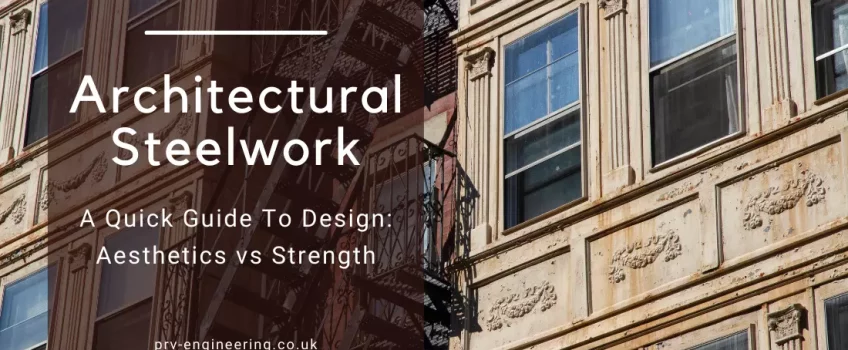
The construction industry is a diverse one, with steel being used in many different ways. Architectural steelwork is an essential part of this and falls into two categories: structural steel and non-structural steel. In this article, we take a quick look at the differences, processes and how PRV Engineering works.
Structural Steel vs Non-Structural Steel
Structural steelwork is the more widely known form of architectural work but still covers all the possibilities open to architects who want to use structural steelwork as an architectural feature.
Non-structural steelwork is often thought of as “functional” or “utilitarian” structures such as balustrades, stairs and ramps. In some cases, non-structural structures are not necessarily built with strength in mind and could purely be for aesthetic purposes.
What Is Architectural Steelwork?
Architectural steelwork is sometimes referred to as “feature steelwork” and involves the design and fabrication of steel as an architectural feature of a building or structure. It fits everywhere in the construction industry, from commercial buildings such as offices and hospitals to private houses and gardens.
Architectural Steel Structures are technically defined as such by the British Standards (BS) and should refer to BS 1192: Part 2: 1996. It states: “General rules for composite metal decking with concrete floor slabs supported on profiled metal sheets”. This refers to building structures such as balconies and walkways.
Architectural steel structures designed by architects instead of engineers should refer to BS 4449: Part 1: 1990 “Specification for Architectural Structures”. In this instance, it applies only when the structure is not in direct contact with soil. If it is, then it should be made of concrete and reinforced steel.
Does Architectural Steelwork Have To Be Load-Bearing?
Architectural steelwork does not have to be load-bearing and can form part of non-structural walls or partitions. It can also be used structurally to form beams, bracing or sills under windows, for example. Architectural steel is fabricated in a similar way to structural steelwork where fabrication takes place on-site or off-site. The architectural steel fabrication process is generally less detailed than structural steel fabrication as the metals are typically lighter for aesthetic rather than strength purposes.
Architectural metalworkers do not have to take into account the load-bearing capacity of their work, but they should consider its durability and resistance to corrosion. Architectural metalwork can also be painted during fabrication if required for aesthetic reasons.
The Important Role Of Architects
Architects are responsible for designing buildings according to client requirements while ensuring that they meet safety regulations and follow sound construction principles with BAL (British Approval Level). This will depend on the type of structural steel or architectural steelwork used, whether it’s RSJ’s, staircases or balustrades among others.
While fabricators, like PRV Engineering, are ultimately responsible for fabricating, architects must ensure that all safety regulations are met. They may also specify architectural metalwork detailing in their construction documents which must be followed during the process.
The Role Of Structural Engineers
Structural Engineers design the steel structures according to the client’s requirements which is usually an architect or property developer. The structural engineer will design the main structure using RSJs or other materials whilst other components such as handrails and balustrades are often the architect’s responsibility.
In architectural steelwork, the metals can be designed in various ways depending on their application within a construction project. To summarise what we mentioned earlier, architectural metals could be:
- Structural architectural steelwork which supports the weight of other construction materials or itself
- Non-structural architectural metalwork that helps to add aesthetic value to the structure rather than reinforcing it
Using Lower Grade Steel: Aesthetics vs Strength
Structural architectural metalwork must support the weight of other construction materials or itself. They are typically fabricated from steel that can achieve a grade of at least S355 in accordance with BS EN 10025-2:2004, the European standard for hot-formed structural steel shapes.
However, in some instances, aesthetics are more important than strength which results in the use of lower-grade steel despite being less resistant to corrosion. While the choice of material largely depends on the customer and project requirements, everything should be done in accordance with the British Standard recommendations for structural stability, safety and accessibility.
Architectural Steelwork At PRV Engineering
At PRV Engineering, our wide range of solutions comply with all the necessary building regulations and requirements. We have a reputation for delivering from the simplest to the most complex and technically challenging projects which not many companies can do within budget and on time.
Our work involves installing products at various locations including factories, warehouses, offices, schools, medical facilities, retail units, sports facilities and residential buildings. Contact us if you need help with your architectural steelwork or any other fabrication project, including aluminium.


 Mail:
Mail: 



